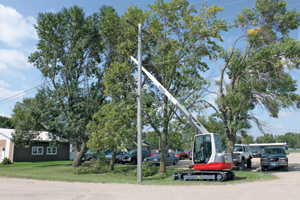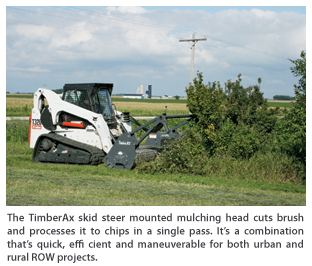Clear Path Projects

Like most other industries in these times, right-of-way (ROW) maintenance and ROW contractors are constantly being challenged to become more efficient. According to the U.S. Dept. of Energy, there are approximately 1.5 million miles of right-of-way in the U.S. electric power grid. In order to maintain reliability of this system, crews need to continually fight back the non-stop growth of brush and trees impeding on the lines. While this means there is literally no end to the amount of work needed to hold back the vegetation under these lines, the funds available to do the work are limited.
The utility companies, working of behalf of all of us electricity users, have to work within a very tight budget to maintain the distribution grid. In the manufacturing environment, companies like Loftness have met similar challenges by upgrading to modern equipment that is more precise and more productive, while using less manual labor to tackle these problems. Right-of-way maintenance contractors are no exception, and have been evolving towards more mechanization with less manual labor as well.
 For years, the accepted means of clearing heavy brush or trimming branches was chainsaw crews, either on foot, climbing or in bucket trucks, manually feeding chipper trucks that would haul the material away for disposal. In less populated rural areas, tractor-mounted, flat deck rotary mowers have been used to mow smaller trees and brush under the lines. More recently, horizontal drum mulching heads (fixed carbide teeth or swinging hammer type) have been gradually taking the place of the rotaries because the discharge trajectory is much more controlled, allowing operation somewhat closer to populated areas and along roadways.
For years, the accepted means of clearing heavy brush or trimming branches was chainsaw crews, either on foot, climbing or in bucket trucks, manually feeding chipper trucks that would haul the material away for disposal. In less populated rural areas, tractor-mounted, flat deck rotary mowers have been used to mow smaller trees and brush under the lines. More recently, horizontal drum mulching heads (fixed carbide teeth or swinging hammer type) have been gradually taking the place of the rotaries because the discharge trajectory is much more controlled, allowing operation somewhat closer to populated areas and along roadways.
Also, the drum type mulchers can cut larger trees, grind the material finer and return it directly back to the soil as a mulched product. This process eliminates manual feeding chippers and trucking material away to a disposal site. Understandably, the use of the horizontal drum mulchers has had a significant impact on the move toward mechanization in this industry.
Graduate to Specialty Equipment
The introduction of the self-propelled, insulated boom trimmers also had a large impact on the industry, making it possible for a single operator to safely move along the ROW and trim branches up to 70 ft in the air from an operator’s platform close to the ground. It is easy to imagine the efficiency this type of machine brings to the process, compared to a bucket truck moving from tree to tree lifting a man and saw up to each individual branch that needs to be trimmed.
Workers operating these self-propelled machines (mulchers and trimmers), will certainly be more productive working in a climate controlled cab, as opposed to doing manual labor out in the elements. They should also enjoy greater job satisfaction looking back and judging their accomplishments at the end of the day.
It is understood that we will not completely eliminate the need for manual ground crews, climbers, bucket trucks and chippers. In fact, there are many instances where that is the only reasonable approach. These labor intense processes are best suited for work inside densely populated urban areas or in very difficult terrain. With the current budget pressures and changes in our workforce (less people willing to do the manual labor), it becomes even more important that crews graduate to using equipment to do as much of this work as they possibly can.
But we do need to crowd that line between the use of urban labor crews and the rural equipment crews, closer in to the edge of the metro areas.
Compact ROW Equipment
Originally, most of the self-propelled equipment was designed on a very large scale, intended mainly for the rural transmission line work. Seventy-ft trimmers weighing over 20,000 lbs need relatively large areas to maneuver and require a semi tractor/trailer to transport to the jobsite. Many of the earlier horizontal drum mulchers were similar in size, weight and hauling equipment needed.
While equipment this size is very productive, and easily accepted in the rural environment, it may not be welcomed working under distribution lines in the backyards and alleys of the suburbs. The impact on the ground surface, noise levels, even the truck needed to haul the unit, would be out of place in these areas.
An important part of a ROW contractor’s success is based on maintaining a good relationship with the landowners that are impacted by the work being performed. If we want to bring the advantages of a mechanized operation into these neighborhoods, the equipment needs to be smaller, quieter and just less intimidating.
Equipment manufacturers are recognizing this need and answering it with new compact equipment that will serve the same purposes, but on a much smaller scale.
Over the past several years, the skid steer manufacturers have stepped up the hydraulic power available and mulching head manufacturers have produced heads that are carefully matched to that application. When combined, it can be a very effective mulching package for its size.
To complement the compact mulchers, Loftness is offering a compact self-propelled trimmer with a 53 foot cutting height. Based on a mini excavator chassis, the compact trimmer weighs about the same as a skid steer loader, so it can be hauled to the job with the same pickup and trailer.
This type of compact equipment should make it easier for the ROW contractor to gain acceptance and access into the more populated areas. The compact trimmer and mulcher should be far less intimidating if they resemble the skid steers and mini excavators that the customers often see on jobsites within the metro areas.
Of the 1.5 million miles of ROW in the electricity distribution grid, approximately 157,000 miles are considered transmission lines that would typically be maintained by the larger scale equipment. Underground lines account for another 310,000 miles. This leaves approximately 1,033,000 miles of ROW in the distribution line category. A large portion of those million miles of work out there could be handled with this type of compact equipment, resulting in a much more cost-effective and thorough job. Most importantly, the mechanized operation provides a safer environment for our workers.
Bill Schafer is the product manager for Loftness Mfg., based in Hector, Minn. Bill wrote this article with help from Jeff Link, general foreperson (Special Eq.) at Asplundh Tree Expert Co., Kevin Fitzpatrick, fleet manager at Wright Tree Service, and Ed Fletcher, research and development manager at Loftness Mfg.


Comments are closed here.